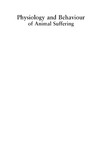Suffering is a state of mind that is difficult to measure and analyse in human beings and considerably more so in animals. It is related to the environment in which we live and our physical and mental states. Understanding the physiology of suffering in animals is crucial in assessing animal welfare.
Written by an expert in applied welfare aspects of physiology, this book is the first to address the physiological aspects of suffering in animals. It explores the different causes of suffering – physical discomfort, thirst and hunger, the responses in the body that lead to suffering and it offers insight into how suffering can be managed.
- The second book in a major new animal welfare series
- Draws together information that is scattered across the literature
- Written for the specialist and non-specialist alike
- Includes colour pictures
This book is part of the UFAW/Wiley-Blackwell Animal Welfare Book Series. This major series of books produced in collaboration between UFAW (The Universities Federation for Animal Welfare), and Wiley-Blackwell provides an authoritative source of information on worldwide developments, current thinking and best practice in the field of animal welfare science and technology. For details of all of the titles in the series see www.wiley.com/go/ufaw.
Content:
Chapter 1 Introduction (pages 1–11):
Chapter 2 Stress (pages 12–21):
Chapter 3 Anxiety and Fear (pages 22–31):
Chapter 4 Emotional Numbness and Deprivation (pages 32–45):
Chapter 5 Aggression, Overcrowding and Discomfort (pages 46–55):
Chapter 6 Exercise (pages 56–63):
Chapter 7 Cold (pages 64–71):
Chapter 8 Heat and Burns (pages 72–82):
Chapter 9 Thirst and Hunger (pages 83–93):
Chapter 10 Pain (pages 94–130):
Chapter 11 Trauma (pages 131–182):
Chapter 12 Sickness and Disease (pages 183–192):
Chapter 13 Digestive System (pages 193–200):
Chapter 14 Poisoning (pages 201–206):
Chapter 15 Respiratory System (pages 207–222):
Chapter 16 Dying (pages 223–231):
 |
|
О проекте
|
|
О проекте


